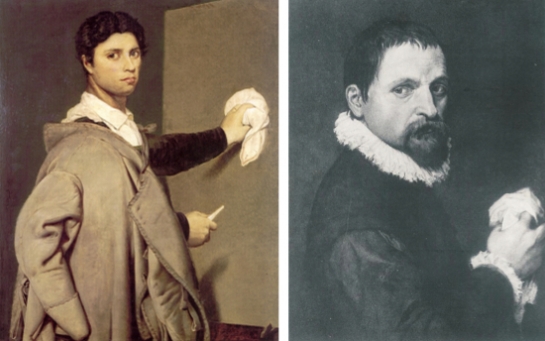Bless you! It’s Art

Left: After Ingres' 1806 Self-portrait
Right: Francesco Salviati, Portrait of a Man with a Handkerchief (c.1540-50)
Keep your eye open for a handkerchief or white cloth. They can be highly significant. My own experience suggests that those who are not painters themselves are relatively unaware that a cloth is almost as important to the craft of painting as a brush or palette. Painters usually keep one nearby to wipe down a canvas or spread pigment over it. Besides, used carefully, it provides special effects as well. Yet despite its importance a copy of Ingres’ 1806 Self-portrait (above left) is a rare example of an artist actively using a cloth, not a paintbrush.
The portrait at right by the sixteenth-century painter, Francesco Salviati, is now in the Uffizi Gallery, Florence. It was once thought to be a self-portrait, perhaps for the reasons given. It resembles an artist in front of a canvas turning to look over his shoulder at a model. I do not know why it is now called Portrait of a Man with a Handkerchief but, if correct that it is a commissioned portrait and not a self-portrait, its meaning is quite ironic. To a patron a handkerchief would probably have symbolized a somewhat refined accessory appropriate to a man of means not involved in manual labor; to a painter, though, a white cloth would have symbolized a working craftsman way further down on the social scale. Though a handkerchief might be very different to the coarser fabric of a white cloth, in art they might look the same.
So don’t forget. If you see a figure holding a handkerchief or a piece of white cloth – as both men do above – decide whether, on the underlying level, he may instead signify an artist. Happy hunting.
Posted 11 Jul 2012: Brushes / PalettePosesIngresPortraiture
The EPPH Blog features issues and commentary.

Reader Comments